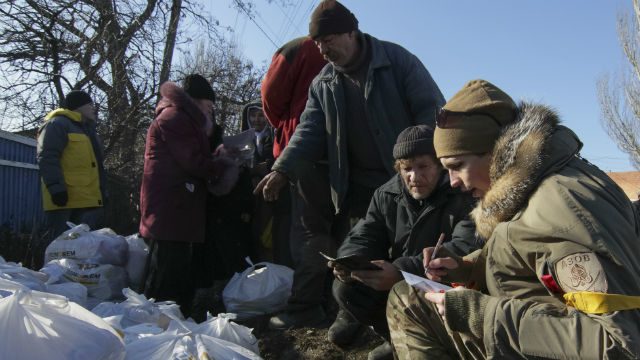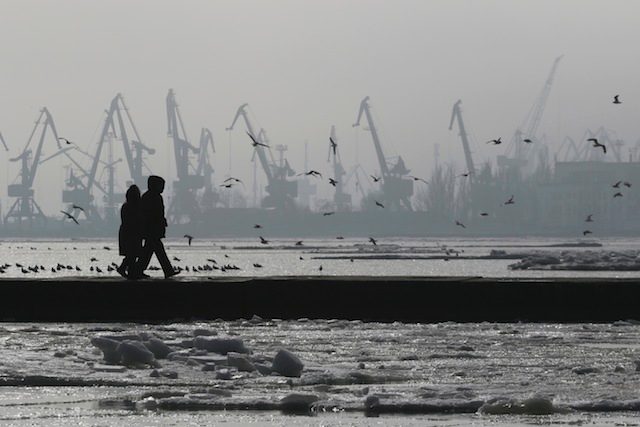SUMMARY
This is AI generated summarization, which may have errors. For context, always refer to the full article.

YENAKIEVE, Ukraine (UPDATED) – Shelling and mortar fire thundered around a flashpoint east Ukraine town on Sunday, February 15, despite a new, shaky ceasefire largely observed along the rest of the frontline separating Ukrainian forces and pro-Russian separatists.
The sporadic bombardments targeting the key railway hub of Debaltseve – where thousands of Ukrainian soldiers are mostly surrounded by the rebels – were audible some kilometers (miles) away. Their intensity was far less than before the truce came into effect at 2200 GMT Saturday, February 14.
Ukraine’s military said that across the entire conflict zone, its soldiers’ positions had come under fire from the rebels 60 times on Sunday. Debaltseve, it said, was “the main hotspot”.
The pro-Russian insurgents “shot using every kind of weapon, including Grad (multiple) rockets,” military spokesman Anatoliy Stelmakh told Agence France-Presse.
The separatists for their part said the truce was largely holding, but accused the other side of occasional breaches.
In Paris, French President Francois Hollande declared that observance of the ceasefire was “generally satisfactory” despite some “local incidents”.
Hollande – who along with German Chancellor Angela Merkel had helped mediate the ceasefire agreed on Thursday, February 12 – was speaking after a 4-way telephone conversation with Merkel and the leaders of Ukraine and Russia.
Ukrainian President Petro Poroshenko emphasized in the call that the ceasefire should be implemented all along the frontline, “including the area of Debaltseve,” according to a statement from his office.
The truce is meant to be the first step of a peace plan aimed at ending 10 months of conflict that have claimed more than 5,480 lives.
The next phase is scheduled to see both sides pull their heavy weaponry back from the frontline within 48 hours of the ceasefire coming into effect. Theoretically, that would be from 2200 GMT Monday, February 16, if the truce is deemed to be fully in force.

A prisoner exchange would then to be made, and Kiev is afterwards meant to start retaking control from the rebels over its 400-kilometer (250-mile) border with Russia, following local elections in the east by the end of the year and negotiations over greater autonomy for separatist-held territories.
Truce ‘threatened’
But there is little trust on all sides. Skepticism reigns after the collapse of a similar ceasefire agreed in September.
Agence France-Presse journalists near Debaltseve heard fire from big artillery guns, mortars, machineguns and snipers throughout the day. They were unable to get into the town itself because of the hostilities.
“There was firing all night and all day,” said a rebel commander, Oleg, at an insurgent base in an abandoned mine near Debaltseve. Around him tanks were stationed in firing positions.
“The ceasefire is just to organize a rotation resupply of the troops,” he said, as heavy weapons and small arms fire kept up a racket of detonations.
“We’re just waiting for the order to launch the assault on the town, which will no doubt happen in a few days,” Oleg added.
The strategic transport hub of Debaltseve is seen as the weak link in the ceasefire.
Poroshenko has warned the truce was “threatened” by the separatist action there, while rebels have warned any attempt to move the 5,000 government troops they claim to have cornered in Debaltseve would be countered.
Observers from the Organization for Security and Cooperation in Europe (OSCE) mandated to monitor the truce say rebels have blocked their access to the town, which they will try again to reach on Monday, February 16.
The OSCE added, however, that it had determined that the ceasefire was holding on Sunday, “with some exceptions”, most notably Debaltseve where its observers “heard artillery and Grad shelling during a 69 minute period”.
International pressure
International pressure is high on both sides to stick to the latest deal and prevent an escalation of the worst East-West crisis since the end of the Cold War.
Washington and Kiev accuse Moscow of fueling last-gasp fighting that occurred just ahead of Saturday’s ceasefire by pouring arms across the border to help rebels grab territory. Moscow denies the claims.
The EU has warned it could toughen its sanctions on Russia if the situation fell apart, while US President Barack Obama has warned he could start supplying arms to Ukraine if the truce collapses.
Russian President Vladimir Putin was said to have reaffirmed his commitment to the peace deal in a call with Merkel and Hollande.
The UN Security Council is expected to meet in emergency session Sunday to shore up the truce. – With Max Delany in Kiev, Agence France-Presse/Rappler.com
Add a comment
How does this make you feel?
There are no comments yet. Add your comment to start the conversation.